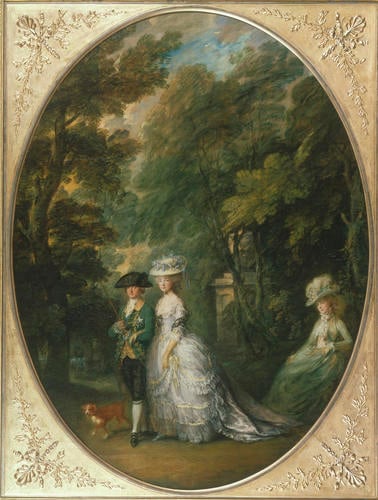-
1 of 253523 objects
Henry, Duke of Cumberland with Anne, Duchess of Cumberland, and Lady Elizabeth Luttrell c.1785-8
Oil on canvas | 163.5 x 124.5 cm (support, canvas/panel/stretcher external) | RCIN 400675
-
Having trained with Hubert Gravelot, Gainsborough produced small scale conversation pieces with a characteristic French elegance and a rococo flourish of the brush. However, having turned his back on this way of working as unsuitable for fashionable Bath, where he moved in 1759, or London, where he spent the last fourteen years of his life, Gainsborough seems to have revisited its possibilities in the 1780s. The Mall of 1783 (Frick Collection, New York) illustrates the same location as St James’s Park and the Mall, attributed to Joseph Nickolls (Royal Collection), but instead of treating the scene with a mixture of topography and satire, Gainsborough sees a fashionable parade as a poetic evocation of female beauty, as mythology in modern dress. His inspiration comes from Antoine Watteau, an artist still generally admired in England sixty years after his death. Gainsborough himself owned a set of the Recueil Jullienne, a series of prints after Watteau’s works.
In his late work Gainsborough re-interprets Watteau with a loosely-woven fabric of long brush strokes, creating a more veiled, mysterious and poetic type of image. James Northcote said of The Mall: ‘You would suppose it would be stiff and formal with the straight rows of trees and people sitting on benches — it is all in motion, and in a flutter like a lady’s fan. Watteau is not half so airy’ (William Hazlitt, Mr Northcote’s Conversations, 1829). The Mall was said to have been executed for George III, for whom in 1785 he also planned a companion, the ‘Richmond Water Walk’, depicting another royal park. The Morning Herald of 20 October 1785 reported that Gainsborough ‘is to be employed, as we hear, for Buckingham House on a companion to his beautiful Watteau-like picture of the Park-scene, the landscape, Richmond water-walk, or Windsor — the figures all portraits’. The King rejected The Mall as inadequately topographical; nothing came of its companion beyond a group of figure studies.
This famous portrait group belongs with Gainsborough’s revival of interest in Watteau. It is unique for its date for its oval format and its figure scale (quarter- as opposed to full-life size). It was commissioned by the sitters but remained in Gainsborough’s possession till his death and only joined the Royal Collection when acquired by George IV when Prince of Wales in 1792. Gainsborough has caught the effect reminiscent of Watteau of towering trees blocking out all but glimpses of sky, and the way in which sky and trees seem to be frothed up together by the brush. Gainsborough’s shadows are darker and the woodland denser — presumably suggesting the grounds of Cumberland Lodge in the Great Park. The colour of Gainsborough’s sky is also more intense and dramatic than Watteau’s: the atmosphere of the image derives from the fact that the spectrum of the evening, from gold to blue, with greys, pinks and violets between, appears in the sky, even if in snatches, and is echoed in the colour of the leaves.
While the Duke and Duchess take a romantic stroll in the summer evening, they are watched by Elizabeth Luttrell, looking wistfully after them, carrying a porte-crayon, with which to record the scene. She has the air of an Echo, fading away with unrequited love for her Narcissus.Provenance
Acquired by George IV; recorded in store at Carlton House in 1816 (no 251) and 1819 (no 36); taken to Cumberland Lodge in 1823; in the Grand Corridor in Windsor Castle in 1858
-
Creator(s)
Acquirer(s)
-
Medium and techniques
Oil on canvas
Measurements
163.5 x 124.5 cm (support, canvas/panel/stretcher external)
189.7 x 149.2 x 12.0 cm (frame, external)
Category
Object type(s)
Other number(s)
Alternative title(s)
Henry, Duke of Cumberland (1745-1790) with the Duchess of Cumberland (1743-1808) and Lady Elizabeth Luttrell (d.1799)
